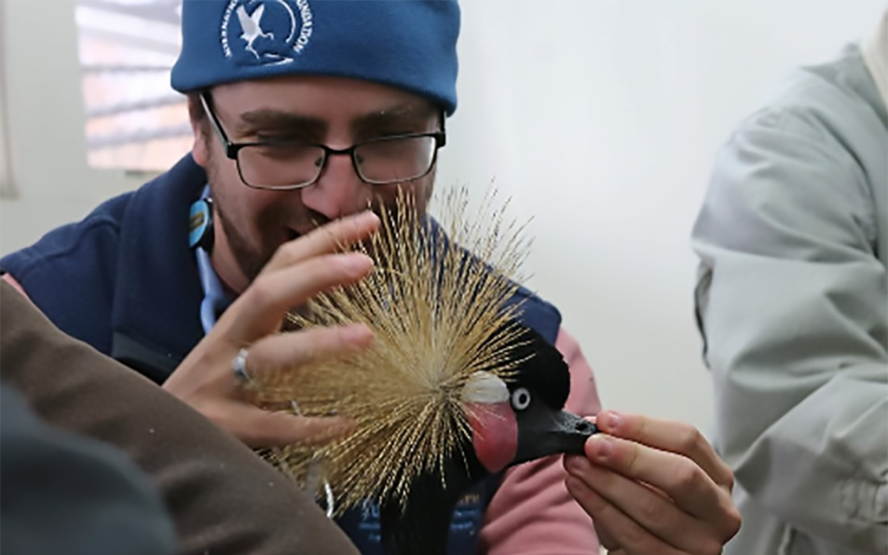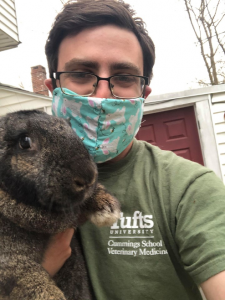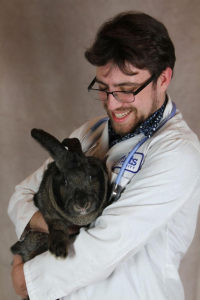-
About
- Leadership & Faculty
- News & Events
-
Academics
- Graduate
- Advanced Clinical Training
- Continuing Education
- Academic Offices
-
Student Life
-
Research
-
Hospitals & Clinics
- Emergency Care
- Hospital Services
-
Community Outreach
- Volunteer
Bird Call
Jason Doll, V20, MPH20, followed a love of poultry to veterinary medicine and public health

When it comes to which came first—the chicken or the professional path—Jason Doll, V20, MPH20, said the answer would have to be the chicken.
“I distinctly remember helping my grandfather raise guinea hens when I was eight,” said Doll. “That's how I started falling in love with birds.”
From that point on, Doll wanted to be a veterinarian.
Doll, who grew up in the shadow of Penn State University, said he was lucky to have access to an array of extracurricular agricultural activities and pre-veterinary camps.
For his undergraduate education, Doll sought out a school that offered even more hands-on exposure to animals. He chose Delaware Valley College to pursue a B.S. in zoo science, animal biotechnology, and conservation. There, Doll had the opportunity to both shadow small-animal veterinarians and take poultry courses—and found he was still drawn to birds.
“Birds are modern dinosaurs, and one of the coolest things is how you can see adaptation and Darwinian origin stories so clearly in them,” said Doll. “I love how an egg is just this perfect little package of nutritious material that has to survive on its own, while something sentient develops inside.”
While an undergrad, Doll spent a summer as a student poultry researcher at Penn State, where a team was investigating ways to create a more environmentally friendly poultry facility.
“Poultry waste creates a lot of ammonia gas in the air, which can be not only toxic to the birds but also to the environment and any waterways nearby. Penn State was doing environmental research specifically on vegetative buffers,” explained Doll. “They found that certain plants—like Miscanthus grass and the Norway spruce—are able to take that ammonia and convert it to nitrogen that’s helpful for those plants metabolically.”
That experience is what inspired him to pursue a Master of Public Health at Tufts School of Medicine in combination with a D.V.M. from Cummings School of Veterinary Medicine.
“That's what got me started,” said Doll. “Birds are cool. Humans are cool. But their interface is even more tantalizing.”
One Medicine, One Health
At Cummings School, Doll found ample opportunities to explore the relationships between animal, human, and environmental health.
For example, Doll traveled to southeastern Alaska to conduct public outreach and education for his M.P.H. thesis. He spent eight weeks in the greater Anchorage area, talking to backyard poultry owners about their biosecurity practices and how these can affect other domestic flocks and migratory birds.
Although Doll went into his research project concerned mostly about the risk of transmission of avian influenza between backyard birds and native species, he came away with an understanding of other hazards.
“In Alaska, it’s common to see these swap meets, which are sort of like a farmer’s market with live animals,” Doll explained.
Birds are brought up to Alaska from the Lower 48. But Doll’s study revealed that no one quarantines these new animals for any period of time. The swap meets also don’t have handwashing stations where people can disinfect themselves between handling different animals.
“Buyers don’t have any medical records for a bird they may buy from a neighbor for five dollars,” Doll continued. “That animal is then right back to their house, without sanitizing the car coming from the swap meet, which may be rife with disease.”
As with all interventions for public health—including those to slow the spread COVID-19 worldwide—the challenge for veterinarians and other health professionals around Alaska’s swap meets will be to convince individuals of their role in the greater good.
“You have to find a way to convince a group of individuals that their behavior is not just about their own health, but rather the health of the whole community,” said Doll. “In Alaska, the attitude toward poultry biosecurity seemed to be, ‘I don’t care. My flock is fine.’ But when you have free-ranging poultry, there is risk of spreading disease to wild birds in the environment and, even more likely, your neighbors’ chickens.”
Looking Ahead
As for all Tufts students, the COVID-19 pandemic meant Doll’s spring did not go exactly as planned.
One Friday in mid-March, he was cheering on the third-year veterinary students as they transitioned from their classroom education to their clinical year at a campus-only White Coat Ceremony. By that Monday, all students had learned that any remaining rotations and coursework—all electives for the fourth-years by that point—would have to be virtual.
The white coat ceremony “was such a nice last memory of being a V20 with my all-star classmates,” he said.
Doll hasn’t lacked for ways to fill his time in the days that followed, however.
He continued his veterinary education via online veterinary courses. He burned off stress by running cross-country in Grafton, teaching himself to play the lyre, and staying connected to friends and family through Zoom.
Doll has even found ways to remotely volunteer to help both pets and people. He has been drawing pet portraits for donors to raise money for a Philadelphia animal shelter, as well as consoling grieving pet owners through Cummings School’s student-run pet-loss hotline.
Now back home in Pennsylvania, Doll soon will start a job as a staff veterinarian for a local VCA animal hospital. “I am putting poultry on hold for now,” he said. “Tufts does an amazing job of preparing you to be a small-animal general practitioner, so I want to see how I enjoy working as one full-time. But I'm thinking of doing a poultry residency someday.”
For all his love of poultry, Doll does not own a single chicken of his own. “I've always lived in a place where it was illegal to have backyard poultry.”
However, while at Tufts, Doll got a Flemish Giant rabbit named Buckbeak. Doll worked with Buckbeak to get him certified as a therapy animal through Tufts Paws for People. Over two years, the pair made monthly visits to Westborough Healthcare, a Northborough church, and various university events.
(Doll recently wrote an article for Pet Partners—the national pet-visitation program with which Tufts Paws for People is affiliated—about how COVID-19 affects the safety of pet therapy, and how volunteers can either visit virtually or ensure a proper physical distance.)
“That's another thing that my experiences at Tufts have shown me—the power of the human-animal bond,” he said. “It’s incredible how much joy even the presence of an animal can bring someone.”
Doll will carry that understanding into his work in small animal practice, which he said is at the forefront of public health and herd immunity. Although he chose to pursue an M.P.H. in combination with his D.V.M. he noted that “every veterinarian plays a role in public health—which goes beyond the health of more than just an individual patient to encompass that patient’s family, community, and species.”
Department:
DVM Program

